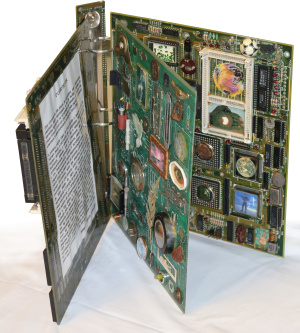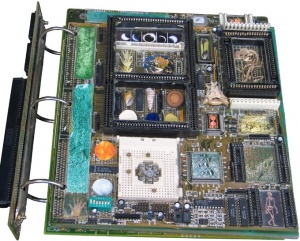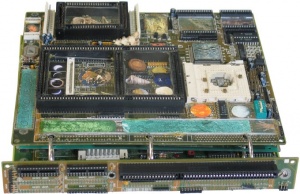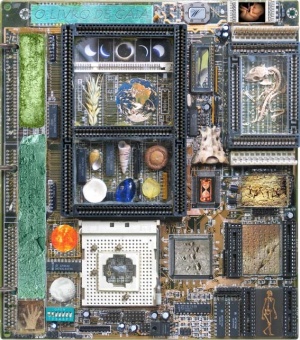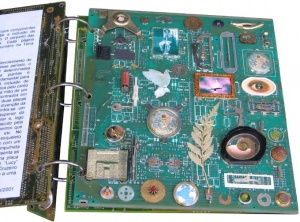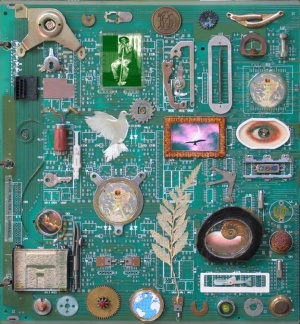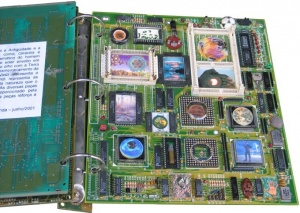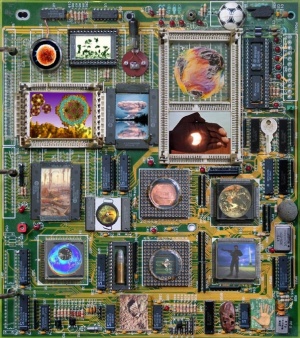Technique: computer board + objects + digitized images
Dimensions: 26 x 27 x 5,5 cm
This work is composed by three computer boards, whose electronic components were rearranged in order to facilitate the inclusion of figurative elements in the composition. The group of the boards forms a book with three pages. Each page representing a stage of the human development at the Earth (Gaia).
The first page (book cover) approaches the mankind development from the Prehistory to the Antiquity.
In that period, Man learned how to observe the sky and to relate certain phenomena with the growth of the plants and, consequently, he learned how to cultivate them, a fundamental pass for mankind’s cultural and technological development. The inclusion of representative images of that development begins for the left inferior corner of the board where is the silhouette of a prehistoric man's hand, author of the drawings and paintings found in a cave. Close to that hand are the images of two mud plates with very old inscriptions, representing the invention of the writing. The board also has two compartments. The first one is divided in three parts, where there are some phases of a solar eclipse; the Earth and a wheat, the food supplied by the mother Earth (Gaia) and some elements that represent the nature, such as, shells, flowers, seeds, etc. The second compartment has a skeleton representing a prehistoric fossil, the same happening with a bone put outside of the compartment. Below a hour-glass represents elapsing of the time. Another image shows the oldest human footprints found until today. A plate with cuneiforms inscriptions is above the skeleton of "Lucy", supposedly the oldest ancestral of the human being. The Crux (some stars viewed in south hemisphere) is represented through metallic stars close to a chipped stone.
The second page approaches the period between the Antique and the Industrial Revolution. Several elements, such as, snails and spirals represent the mankind mathematical development reached by the observation of the nature. The solar eclipse wrapped up in clouds and a crow in foreground, represent the effective superstition in that period and the eye with the Earth in its center represents the religious mysticism. The illustration of a man (vitruvian man) drawn by Leonardo of Vinci (divided in two parts) represents the humanism in Renaissance; and the world map represents the great navigations and the sense of domain on the nature that Man believes to have when creating territorial divisions. Several mechanic pieces represent the development provided by the Industrial Revolution and the illusory human domain on the nature.
The third page approaches the period between the Industrial Revolution and the current moment.
Several images and elements in the board represent situations or the proper circumstances of our days. The images of the Earth, without water and with the hole in the ozone layer, represent the fragility of the humankind concerning the scarceness of the natural resources due to an exploration, which is not consistent with the quality of life that all we want. In that sense, the image of the Earth inside of a clock reinforces the concept of little time to avoid an apocalyptic situation. The atomic mushroom and the clock destroyed by the bomb in Hiroshima represent the dangers that the badly use of the technology can cause. A soldier's image and a bullet represent the current violence. The birds on a lot of garbage, a burned forest and the virus image attacking a cell represent the loss of quality of life currently. The images of spermatozoids trying to penetrate an ovule and the solar eclipse reflected on a hand demonstrates the understanding that the human knowledge brought on the phenomena of the nature. In the right inferior part of the board, the image of a hand on a computer board (my hand) makes a connection with the prehistoric man's hand (in the first page), as if it was a signature of the humanity, but also as if it represented a forbidden sign for the irresponsibleness practiced by the humanity nowadays.
Walter Miranda – June/2001
